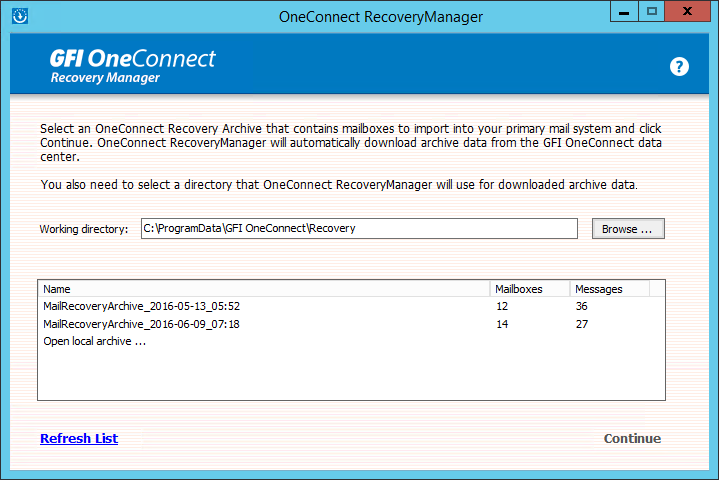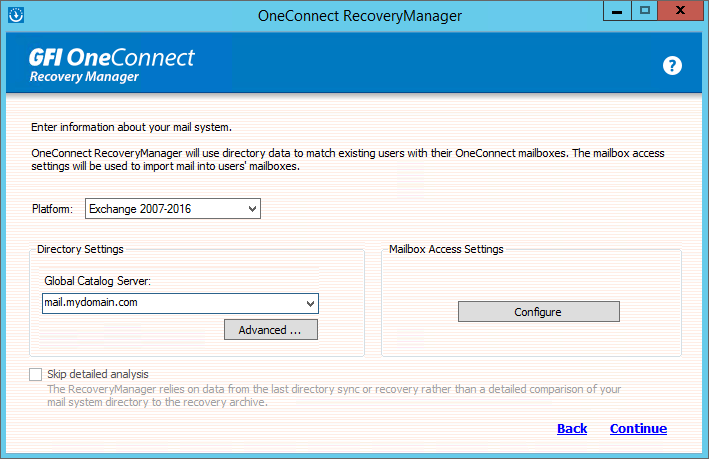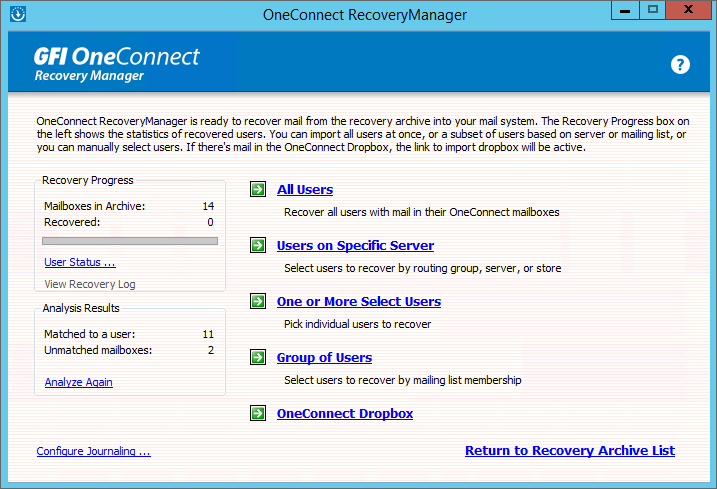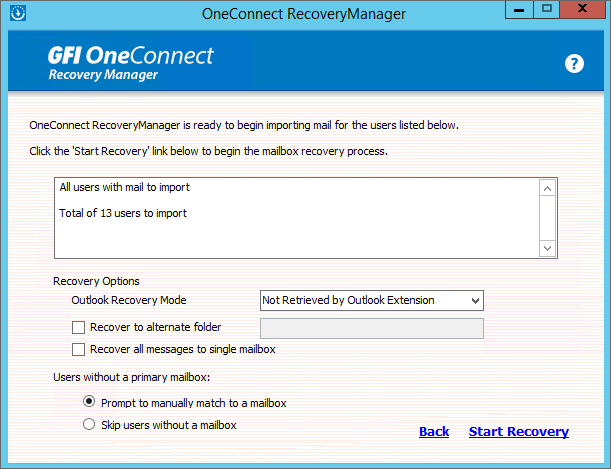Recovering from an Activation
The recovery process allows you to reintegrate all emails handled by ContinuityA feature provided by GFI OneConnect that queues the emails sent and received in a Data Center and ensures that your organization can keep the mail flow even when the email infrastructure is down. during an activation, back to your email system. The recovery process typically begins after the organization's email infrastructure is back online and tested. Items that are recovered include:
- Messages received between the mail server outageRefers to a situation when the email server is down or offline. and the Continuity activation process.
- Messages sent or received by active users during an activation of Continuity.
Refer to information in this topic for information on how to complete Recovery.
NOTE
GFI OneConnect implements industry standard RFC-2231-encoded fields. However, certain email clients such as Microsoft Outlook do not properly decode RFC-2231-encoded fields. Therefore on recovery, some attachment filenames may be renamed. However, no information or attachments are lost.
 Step 1: Restore and test your email system
Step 1: Restore and test your email system
Confirm that your email system is back online, ready for user activity and able to send and receive internal and external email.
 Step 2: Terminate Continuity activation
Step 2: Terminate Continuity activation
- Login to GFI OneConnect with an administrator account.
- From the top-right menu, navigate to Manage > Continuity.
- In the Current OneConnect State section, click Start Recovery.

Starting the recovery process
- If partial Continuity activation is enabled, choose whether to recover for all activated users or a subset of users and click Next. If recovering for just a subset of users, choose the users to recover in the next screen.
- Notify users entering the recovery process that the Continuity service is no longer active and that they can resume using the primary email system. This notification is sent on deactivation of a user’s Continuity mailbox. Edit the Subject or Text of the message as required. Remind users that the email data they sent and received during the activation period will be restored to their primary email. You may also inform that users must manually run any custom rules that they have for filtering mail. Alternatively, you can select Don’t send a notification message to not send an email notification and send a custom notification at a later time. Click Next.

Specifying a recovery archive name
- In the ArchiveA feature provided by GFI OneConnect that can archive all internal and external email into the GFI OneConnect Data Center. Name box, key in a friendly name for the archive file that helps you identify it when using RecoveryManager to complete recovery (for example,
ContinuityArchive_20160101). Click Next. - In the Confirmation page click Start Recovery.
NOTE
Recovery archives are available for 30 days after they are created. After that time, they are purged and no longer available. Be sure that you complete the recovery process within 30 days.
 Step 3: Restore Mail to Users’ Mailboxes
Step 3: Restore Mail to Users’ Mailboxes
Use the RecoveryManager to restore email activity back to your email infrastructure.
- On your GFI OneConnect server that hosts RecoveryManager, go to Start > Programs > GFI OneConnect > RecoveryManager.
- Log into the RecoveryManager using a GFI OneConnect Administrator account with sufficient permissions on the Exchange server.
- Click Start Recovery.
- Select the Working directory for RecoveryManager to use as a temporary data store during the import process. Ensure that the directory chosen has sufficient disk space for all mail items. Also ensure that there is no anti-virus or backup software that may be scanning this folder, since it may block important temporary files causing errors. Refer to the anti-virus or backup software’s instructions for how to exclude directories from scans. The default path is:
<system drive>\ProgramData\GFI OneConnect

Choosing the mail archive to recover
- From the list of available recovery archives, choose the archive created in Step 2 above. If you see no archives available, make sure you have created a recovery archive and check in the Continuity dashboard that the creation of the recovery archive is completed. For more information refer to Step 2: Terminate Continuity activation. Click Continue.
- The RecoveryManager downloads the archive metadata into the working directory. Actual mail data is downloaded for each user later in the process.

RecoveryManager global catalog settings
- RecoveryManager uses platform information pulled from SyncManager to access the primary email system. Typically these settings are correct for recovery. If, however, there were changes applied to the mail system, such as changes to the global catalog server or EWSExchange Web Services connection settings, click Configure to adjust these settings.
- During recovery, directory information is compiled as part of the process. If SyncManager is installed, and if the most recent Directory sync was successful, RecoveryManager can use the cached results from the Directory sync for the recovery process. To use this cached data, check the Skip detailed analysis check box.
- Click Continue.
- RecoveryManager analyzes the archive to match up mailboxes in the archive to users’ mailboxes in the primary mail system. The duration of this process depends on the number of mailboxes. Click Continue.

RecoveryManager mailbox and archive statistics
- RecoveryManager shows mailbox and archive statistics to choose how to recover the archive:
| Option | Description |
|---|---|
| Mailboxes in Archive | The total number of mailboxes in the archive. |
| Recovered | The number of mailboxes for which mail has been recovered. |
| User Status | Click to review a detailed status of each user, including usernames per server, user accounts with email data for recovery, and user accounts that cannot be matched to an account on the primary mail system. |
| Matched to a user | The number of user accounts that can and cannot be matched to an account on the primary mail system. |
| Unmatched mailboxes | The number of mailboxes that cannot be associated with a user in the primary mail system. |
| Analyze Again | Click to re-analyze the archive mailboxes. |
| Configure JournalingA feature that generates and sends a copy of every email that passes through the mail server. Do not confuse it with Archiving. |
Click to specify a journaling mailbox where to store a copy of all messages transmitted during activation. This is useful for example when using a mail archiving solution such as GFI Archiver which retrieves mail from a journaling mailbox. Select the group, server or store you want to configure journaling for and click Change. Select the journaling mailbox where to copy all messages to and click OK. Also configure:
|
- In the user selection area, select the users to run recovery for and click Continue.
| User set | Description |
|---|---|
| All Users | Recover email data for all users who were activated during the outage and for which data has not yet been recovered. |
| Users on Specific Server |
Recover email data for users on a selected message store, server, or group of servers. Check any combination of individual mail stores, servers, or server groups for recovery. (Servers without users that need recovery are grayed out.) Click Continue. |
| One or More Select Users |
Recover the mailbox of one user or the mailboxes of selected users by name. Select/Search users to recover and click Add to copy them to the user list in the right column. You may also override the destination of the user’s restored email data. Select a user and click Properties to configure. Click Continue. |
| Group of Users |
Recover users based on distribution list membership. RecoveryManager lists all distribution lists with members who have email that needs recovery. Select groups and click Add to copy the group to the right column. Click Continue. |
| Dropbox |
This option provides a repository for received emails sent to non-existent mailboxes or addresses not found in GFI OneConnect. If you select this option, select a server and mailbox to which all Dropbox content will be imported. Click Continue. |

Recovery options
- Choose how to restore the mail:
| Option | Description |
|---|---|
| Outlook Recovery Mode |
When using the Outlook Extension, emails processed during a Continuity activation are downloaded by the Outlook Extension and stored in the Microsoft Outlook OST file. When Microsoft Exchange is restored, Microsoft Outlook automatically replicates these emails with the mailbox. Choose what to do with emails processed by the Outlook Extension:
|
| Recover to alternate folder |
Leave this option unchecked to recover mail to the appropriate folder within a user's mailbox. To recover data to a designated folder within users’ mailboxes, select this option and type a name for the folder. For example, if alternate folder name specified is |
| Recover all messages to single mailbox |
Choose this option to recover all messages from the activation to a single mailbox. Select the mailbox. For example, recover all items to an administrator mailbox for troubleshooting purposes. A folder for each user being recovered is created in the administrator mailbox.
|
| Users without a primary mailbox |
Choose how to process any unmatched mailboxes:
|
- Click Start Recovery to begin importing data for selected users. RecoveryManager downloads all mail data from GFI OneConnect data center and imports it to the appropriate mailboxes and mailbox folders.
NOTE
If you click Cancel to stop the recovery process, RecoveryManager first completes recovery of the mailbox that is being processed before stopping.
- Click the link View Recovery Log if you want to see a summary of the recovery process.
- When the mail for all selected users has completed recovery, click Continue. If you need to recover additional mail, click Select another archive to recover to return to the RecoveryManager main screen. If not, select Exit RecoveryManager.
NOTE
Recovery does not import mail in user mailboxes more than once. Even if users or mailboxes belong to more than one group, their data is only imported once. The RecoveryManager skips already recovered user accounts, even if they are members of other distribution lists or groups.
 Step 4: End recovery and delete data
Step 4: End recovery and delete data
Ensure that all email data is successfully imported into the primary mail system before ending recovery. GFI OneConnect retains recovery archives for up to 30 days or until recovery is ended.
IMPORTANT
When ending recovery, all archives are permanently deleted from Continuity and users can no longer access the data through GFI OneConnect. It is, therefore, imperative to verify that mail import was successful before running this step.
To finalize recovery and change the GFI OneConnect state to READY:
- Login to GFI OneConnect with an administrator account.
- From the top-right menu, navigate to Manage > Continuity.
- In Current OneConnect State, click End Recovery to launch the Recovery Wizard.
- Select the scope of the recovery and click Next.
- End recovery for all users in the Recovery state: End the recovery for all users that are part of this activation.
- End recovery for some users: End the recovery for a subset of users only. In the next screen select the users to terminate recovery for.
- On the Confirmation page, click End Recovery. This purges the recovery archive from the data center and returns mailboxes to the READY state.